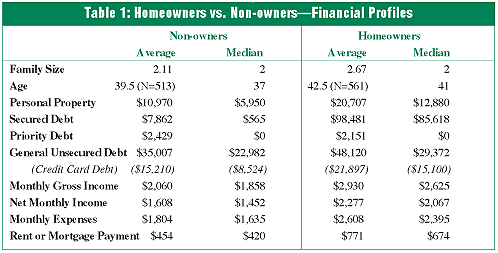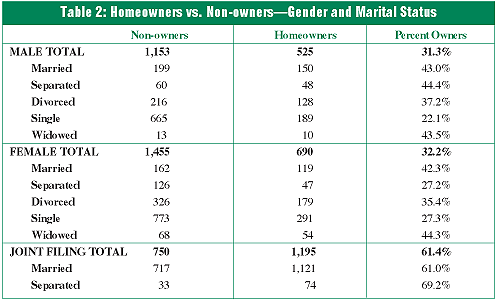Be It Ever So Humble Theres No Place Like Home
Be It Ever So Humble Theres No Place Like Home
In this article, we report on home ownership among no-asset chapter 7 debtors. The report is based on 5,832 non-business chapter 7 cases that were closed between 1999 and 2001.3 We classified each debtor as an owner or a non-owner based on information in Schedules A, C, D and J of their petition.
Most owners occupied ordinary single-family dwellings, but some owned condominiums, trailers or second properties. Separated couples who filed jointly were counted as owners if an owned property was listed on the schedules, even if one of them was a renter. Also included as owners were debtors who held property at the time of filing, but indicated in their filing that they intended to liquidate the property. Most non-owners report on Schedule J that they pay rent for an apartment or house. But we also included as non-owners debtors who appeared to be living rent-free under diverse circumstances—these are approximately 11 percent of non-owners.
National Home Ownership Rates
The home ownership rate in our sample was well below the rate in the general population. The Bureau of the Census reported a national home ownership rate of about 67 percent in the year 2000.4 Among the debtors in our sample, however, the rate was less than 42 percent (2,425 out of 5,832). Thus, while non-owners make up about one-third of the nation's households, they account for more than 58 percent of the chapter 7 filings. We estimate that the chapter 7 filing rate is 2.9 times greater for non-owners than for owners.
Ownership Rates by State
In every state, the rate of home ownership by chapter 7 debtors was lower than the statewide average. States with relatively high ownership rates among debtors5 included West Virginia (60.4 percent), Texas (59.9 percent), Mississippi (56.7 percent), Oklahoma (56.5 percent) and Connecticut (55.8 percent). States with relatively low ownership rates among debtors included Colorado (27.0 percent), Massachusetts (28.6 percent), New York (31.2 percent), California (31.6 percent), Maryland (33.9 percent) and Illinois (33.9 percent).
Home Values and Equity
The median listed value was $80,000, about one-third below the national median of $119,600 in 2000.6 About 5.3 percent of the owners reported a value of $200,000 or more. We cannot report directly on the amount of home equity held by the debtors because our database does not include the balance on each mortgage. We are able, however, to make a rough estimate of the owners' net worth at the time of filing by comparing total real and personal property with total secured, priority and unsecured debt. By this measure, 80.5 percent of the owners had a negative net worth at the time of filing. Whatever equity may have existed in their homes was generally well below other secured, priority and unsecured debts.
Debtors' Financial Profiles
The financial profiles of the owners varied significantly from the non-owners. In general, the owners were a little older, had larger households, more personal property, and higher credit card and other unsecured debt levels. They also reported higher incomes and expenses. Their average mortgage payments were higher than the rent amounts reported by the non-owners. Table 1 compares the average and median (middle) figures for owners and non-owners.

Gender and Marital Status
Table 2 reviews home ownership by gender and marital status. Slightly less than one-third of the non-joint male and female debtors are homeowners. The rate falls to under 30 percent for both male and female debtors who list their marital status as single. Among joint filers, the home ownership rate rises to above 60 percent. In the population at large, about 83 percent of married couple families own homes, while the rates for the various categories of unmarried householders are in the 47 to 58 percent range.

Outlying Cases
Six debtors reported more than $500,000 in real property on Schedule A of their petitions. Closer examinations revealed that in three of these cases, the bulk of the real property consisted of rental or investment property. In one other case, the debtor intended to surrender the home. It appeared that only two debtors (out of 5,832 reviewed) were living in a home valued at $500,000 or more post-bankruptcy. Additionally, neither of these debtors had substantial equity in their homes.
Conclusion
Chapter 7 debtors are far less likely to be homeowners than the population at large. The home ownership rate is lower for chapter 7 debtors in every state and marital status category than it is for the population in general. Debtors who do own homes tend to have little equity in them, and the houses themselves tend to be of modest value. Compared to the non-owners, the owners tend to be older, with higher incomes and larger families, but they also have higher unsecured debt levels and monthly expenses. Non-owners are nearly three times as likely to file chapter 7 bankruptcy than owners are.
Footnotes
1 Payne, John Howard, "Home, Sweet Home," from the opera of Clari, the Maid of Milan, 1791-1852. Return to article
2 All views expressed in this article are those of the authors and do not necessarily represent the views of the Executive Office for U.S. Trustees or the Department of Justice. Return to article
3 Each year since 1998, the Executive Office for U.S. Trustees has obtained a large sample of chapter 7 no-asset cases filed in the 84 federal judicial districts served by the U.S. Trustee Program. Return to article
4 See http://www.census.gov/hhes/www/housing/hvs/annual00/ann00t13.html. Return to article
5 In this analysis, we only include the 32 states for which we had at least 50 cases. Return to article
6 See http://www.census.gov/prod/2003pubs/c2kbr-20.pdf. Return to article
